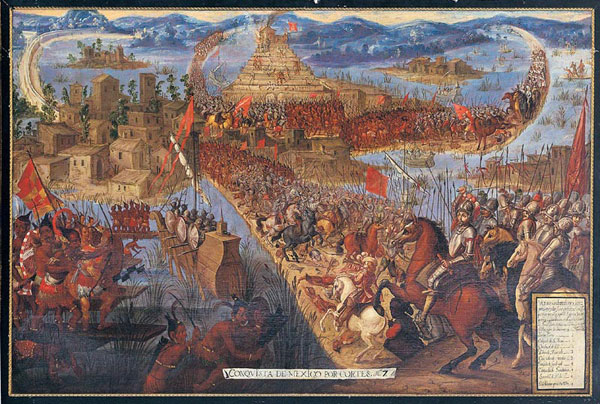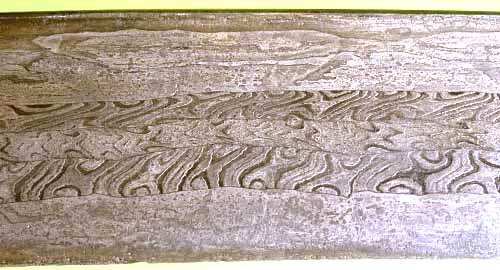Hemogoblin!
Let's not forget that the Amerindians has some pretty sweet stuff too. The Aztecs were the consummate Meso-American imperial force - on the verge of inventing bronze working, it was deemed inferior to their stone weapons.
Which weren't exactly stone - they were carved from volcanic obsidian, which never dulls, and is one of the sharpest natural materials if cut correctly.
 They fielded a professional army, complete with different ranks, organized to a degree that met with contemporary European standards. You could discern the rank of a soldier by his plumes and crests, and often the terrifying skins they worn:
They fielded a professional army, complete with different ranks, organized to a degree that met with contemporary European standards. You could discern the rank of a soldier by his plumes and crests, and often the terrifying skins they worn:

 They dressed as creatures of the jungle, patron animals of their bizarre and bloodthirsty gods. I think it's really easy to underestimate how absolutely terrifying thousands upon thousands of screaming warriors dressed like animals and wielding massive stone axes sharper than steel could be. They basically ruled their empire with a mixture of fear, coercion, and... ritual human sacrifice.
They dressed as creatures of the jungle, patron animals of their bizarre and bloodthirsty gods. I think it's really easy to underestimate how absolutely terrifying thousands upon thousands of screaming warriors dressed like animals and wielding massive stone axes sharper than steel could be. They basically ruled their empire with a mixture of fear, coercion, and... ritual human sacrifice.
That's right. Not only did you lose to the Aztecs, but they basically sacrificed all the captured soldiers, and then exacted a brutal tribute from the captured towns - slaves, sacrifices, and gold. At the height of their empire, they would often slaughter literally thousands of captives at the altars to celebrate a great victory. And not the kind of casual Mongol-esque slaughter. Ceremonial, with terrifying masks and all kinds of things:

Their captial, and sacrificial center, was an island they built in a marsh. It now lies basically underneath Mexico city:

That big central causeway was where the victorious army traveled, leading vast lines of slaves and captives. It was also where they made their last, desperate stand:

Farewell, Aztecs! While most of Meso-America was not sad to see you go, you were less horrible than the Spanish empire which followed.
aryangoku92
Damascus Steel, used by the Saracen fighters during the crusades is something the knights templar were deathly afraid of. It was said it can cut through western swords, armor, even rocks. It never lost its edge and was sharp enough to cut right through a falling piece of silk cloth.

Here's a picture of a pattern-welded sword. Actual Damascene swords from the crusader period had a ladder pattern called a Mohammed's ladder. Some German scientist apparently put one under an electron microscope for whatever reason and discovered the 13th century sword actually contained a fair number of nanotubes. You know, the things they were going to build the space elevator out of.
Sergg
THE ANCIENT MOTHERFUCKIN BATTERY
In 1936, while excavating ruins of a 2000-year-old village near Baghdad, workers discovered mysterious small vase. A 6-inch-high pot of bright yellow clay dating back two millennia contained a cylinder of sheet-copper 5 inches by 1.5 inches. The edge of the copper cylinder was soldered with a 60-40 lead-tin alloy comparable to today's solder. The bottom of the cylinder was capped with a crimped-in copper disk and sealed with bitumen or asphalt. Another insulating layer of asphalt sealed the top and also held in place an iron rod suspended into the center of the copper cylinder. The rod showed evidence of having been corroded with an acidic agent.
German archaeologist , Wilhelm Konig, examined the object and came to a surprising conclusion that the clay pot was nothing less than an ancient electric battery.
The ancient battery in the Baghdad Museum, as well as those others which were unearthed in Iraq, are all dated from the Parthian occupation between 248 BCE and 226 CE. However, Dr. Konig also found copper vases plated with silver in the Baghdad Museum, excavated from Sumerian sites in southern Iraq, dating back to at least 2500 BCE. When the vases were lightly tapped, a blue patina or film separated from the surface, which is characteristic of silver electroplated onto copper base. It would appear then that the Parthians inherited their batteries from one of the earliest known civilizations.
In 1940, Willard F.M. Gray, an engineer at the General Electric High Volatage Laboratory in Pittsfield, Massachusetts, read of Konig's theory. Using drawings and details supplied by German rocket scientist Willy Ley, Gray made a replica of the battery. Using copper sulfate solution, it generated about half a volt of electricity.
In 1970s, German Egyptologist, Arne Eggebrecht built a replica of the Baghdad battery and filled it with freshly pressed grape juice, as he speculated the
ancients might have done. The replica generated 0.87V. He used current from the battery to electroplate a silver statuette with gold.
This experiment proved that electric batteries were used some 1,800 years before their modern invention by Alessandro Volta in 1799.
It also seems that the use of similar batteries can be safely placed into ancient Egypt, where several objects with traces of electroplated precious metals have been found at different locations. There are several anomalous finds from other regions, which suggests use of electricity on a grander scale.
They tested it and got it to work on MythBusters.
A BIG BAG OF KEYS

–
This Week on Something Awful...

Pardon Our Dust
Something Awful is in the process of changing hands to a new owner. In the meantime we're pausing all updates and halting production on our propaganda comic partnership with Northrop Grumman.

DEAR FURRIES: WE WERE WRONG
Dear god this was an embarrassment to not only this site, but to all mankind

Let's improve landmarks
Landmarks and statues around the world: old, boring and could use an update.

Make Horror Wholesome
Join the SA Forum photoshop goons in their quest to make horror wholesome!

Every Conceivable Way EA Could Screw Up Star Wars: Squadrons
Yes, there are finally enough games for a new round of One Sentence Reviews
About This Column
The Comedy Goldmine examines the funniest and most creative threads from the Something Awful Forums. Although the Comedy Goldmine has changed authors many times over the years, its focus on the Something Awful Forums is still the same. Includes hilarious Photoshops, amusing work stories, parodies, and other types of oddball humor.
